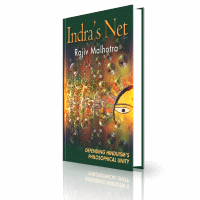Welcome to Indra’s Net
Indra’s Net – Book Summary

It is fashionable among many intellectuals to parrot that dharma traditions lacked any semblance of unity before the British period, and that the contours of contemporary Hinduism were bequeathed to us by our colonial masters.
Such intellectuals often target Swami Vivekananda, accusing him of camouflaging various alleged ‘contradictions’ among the systems of dharma. He gets charged with appropriating ideas from Western religion and science to ‘manufacture’ a coherent worldview and set of practices known as Hinduism. This slanderous thesis is feeding the view that Hinduism is an illegitimate façade with oppressive motives.
This book offers a detailed, systematic rejoinder to such views, and articulates Hindu dharma’s multi-dimensional, holographic understanding of reality. Originating in the Atharva Veda, the concept of Indra’s Net is a powerful metaphor for this inter-relatedness. It was transmitted via Buddhism’s Avatamsaka Sutra into Western thought, where it now resides at the heart of post-modern discourse. This book invokes Indra’s Net to articulate the open architecture, unity and continuity of Hinduism.
Seen from this perspective, Hinduism defies being pigeon-holed into the traditional, modern and post-modern categories by which the West defines itself; rather, it becomes evident that Hinduism has always spanned all three categories simultaneously and without contradiction.
Taking the debate further, Rajiv Malhotra argues that Vivekananda’s creative interpretations of Hindu dharma informed and influenced many Western intellectual movements of the post-modern era. Indeed, appropriations from Hinduism have provided a foundation for cutting-edge discoveries in several fields including cognitive science and neuroscience. Not only self-help gurus and lifestyle coaches but also scientists and philosophers increasingly draw on Hindu cosmology in framing their work.





